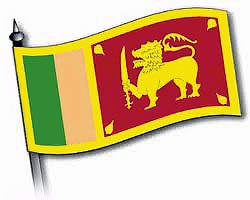
The Sri Lankan national flag is designed in great detail and every detail is symbolic. It is one of the oldest flags in the world. Over the many years and long centuries, a great deal of thought has gone into the flag. Thus, it is not only a symbolic representation of Sri Lanka and its people, but also the code of ethics for the Sri Lankan people.
Roots of the Sri Lankan Flag
Carol Aloysius writes to Sunday Observer on Feb 10, 2002:
Sri Lanka’s national flag is steeped in history and tradition. From its hoary past to the present day, the events linked with this national symbol of freedom and independence are so packed with drama, suspense, and political intrigue that it could easily go down in history as one of the most unique flags in the world.
Much of these fascinating and exciting events has however been forgotten in the mists of time, and many of our younger generation are unaware of the significance and importance of their National flag.
Many may not know that the birth of the Sinhala race began with the planting of the Lion flag for the first time in Lankan history. Here is how H.M. Herath describes this epoch making event in a recently published book on the National flag and National anthem of Sri Lanka.
He writes: “In about 486 BC, Prince Vijaya, the eldest son of Sinha Bahu, King of Sinhapura landed at Tammana with seven hundred companions from his father’s kingdom in North India. So delighted was he, that he took a handful of sand and called it the land of the copper coloured sand, and planted the flag they were carrying (a flag with a lion symbol). He then kissed the sand and called it “Thambani.” So began the history of Sri Lanka, the birth of the Sinhala race.”
If history had not yet begun to be written in Sri Lanka, how do we know about this event? Replies the author, “The inscription of this great and grand event on record is among the archaeological remains at the Sanchi stupa, an ancient Buddhist monument built during the reign of Emperor Asoka in the second century BC in the native state of Bhopal in India.”
Since its arrival in Sri Lanka, the Lion flag has played a significant role in the political history of the country. To our monarchs of yesteryear it became a symbol of freedom and Hope. The warrior King Dutugemunu, used the heraldic lion carrying a sword on his right forepaw with two other symbols, the Sun and the Moon on his banner.
An illustration in the frescoes of the rock temple at Dambulla which traces the beginning of the Lion flag of Sri Lanka shows the victorious king proudly carrying his royal banner depicting the Lion symbol after he freed his people from foreign invaders.
As Herath points out, the lion symbol was used by the Lankan monarchs from the time of King Vijaya. This has been recorded in both the Mahavamsa and the Chulavamsa. The last king to use the flag as a symbol of national freedom was King Sri Vikrama Rajasinghe who was the last king of Sri Lanka, and whose rule ended in 1815.
The Fall and the Rise of the Sri Lankan National Flag
Carol in her article writes,
The ceremony in which the flag was replaced by the British Union Jack was full of drama and colour. Describing it Herath writes: “The Kandyan Convention was proclaimed at 3.30 p.m. on March 2, 1815, in the Audience hall, then called the Magul Maduva of the Palace of Kandy.
This was signed by governor Robert Brownrigg on behalf of His Royal Highness, the Prince Regent, on the one hand, and the Adigars, Dissavas and other principal chiefs of the Kandyan Province. …Outside, drums were beating all around the hall. British troops guarded all the entrances to it and also patrolled the streets. The treaty was next read aloud to the chiefs in Sinhala and both parties agreed to its contents.
Then the Lion flag was hauled down and the Union Jack took its place amidst salvoes of artillery and His Majesty King George III was acclaimed King of Ceylon.”
But the act of hoisting the British flag in place of the Lion flag was premature, a violation of the law, as it was done before the last Kandyan chieftains had signed the treaty, and prompted retaliation from the Maha Sangha, a who were present on the occasion.
Herath re-enacts details of that suspenseful and dramatic epoch making event.
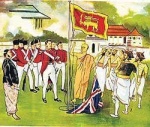
“From amidst the spectators who watched this drama, stepped out a Buddhist monk, the Ven. Wariyapola Sumangala of the Asgiri fraternity. Fortified with confidence, fortitude, self-respect and patriotism he approached the English general to ask, “who gave you permission to hoist your flag here?
You have no right to do so – Yet.” He then proceeded to pull down the Union Jack, trampled it and hoisted the Lion flag in its place. Only after chief Adigar Ehelepola had signed the Convention with much reluctance on March 10 that the Union Jack was hoisted.”
Not many may know that the Royal standard of the last king of Lanka languished in a military hospital in London after the British took control of the Kandyan Kingdom.
According to Herath, it was removed to England by the British Raj and kept in the Royal Military Hospital Chelsea in London until a E. W. Perera, a staunch patriot also known as the Lion of Kotte, discovered it.
The first time the Lion flag became a centre piece of attraction and the public became aware of the actual design of the flag following the fall of the Kandyan Kingdom was when the Dinamina issued a special edition of the paper on March 2, 1915 to mark the centenary of the end of Sinhala independence, with the intention of re-kindling the desire of the people to win back the freedom they had lost to the British, Herath states. He adds, “On the front page were portraits of the last King and Queen of Kandy surmounted by the royal insignia Crown and the Lion flag in colour.
This was the first time since the fall of the Kandyan Kingdom that the people became aware of the actual pattern of their national flag.”
Although the Ceylon Independence Act 1947 passed by the parliament of Britain stated that the flag of the British empire, the Union jack would continue to take precedence over the Lion flag, the national leaders of the time were openly opposed to such a decision.
Still, barely nineteen days prior to the dawn of Independence Day, Lanka’s first Prime Minister Mr. D. S. Senanayake’s cabinet had yet not taken a decision with regard to hoisting the National Flag on the first independence celebrations of February 4, 1948.
CV Vivekananthan details the events that led the Lion Flag to be adapted as the Sri Lankan national flag in his article, ‘How National is Our National Flag?’, that was published in Sunday Times, Feb 2, 2003.
The ‘Lion Flag’ of the last King of Kandy, was hauled down when the Kandyan Convention was signed on March 2, 1815. Though it was buried in the sand of history, E. W. Perera discovered the banner at the Chelsea Hospital and made reference to it in his book on ‘Sinhalese Banners and Standards’.
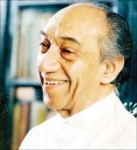
JR Jayewardene was the first to proclaim the use of the Lion Flag as the national flag of Ceylon. Addressing the State Council in September 1945. He said ‘It is the flag that held sway over three portions of Lanka – Ruhuna, Rajarata and Mayarata. It is a yellow flag with a lion in the centre’.
JR drafted a motion and with his machiavellian tactics persuaded Batticaloa MP A. Sinnalebbe to present it in the House of Representatives on January 16, 1948. It read: “That this House is of opinion that the Royal Standard of King Sri Wickrama Raja Sinha depicting a yellow lion passant holding a sword in its right paw on a red background, which was removed to England after the Convention of 1815, should once again be adopted as the official flag of Free Lanka”.
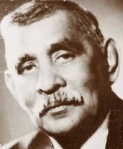
Prime Minister DS Senanayake: “It is a well known fact this flag happens to be the flag of the last King of Kandy, and we all know that the last King of Kandy was a Tamil. When we lost our country, when the people chose the King of England as their Sovereign, this was the flag of the last Kandyan King who was dethroned, that was pulled down. Now that England is transferring sovereignty to the people of this Island, I want England also to replace that flag along with the sovereignty that they are giving us back. It is for this main reason that we intend hoisting this flag on Independence Day.
“It was really a surprise to me to find my good friend, the Muslim Member, trying to show that we want to impose something on them. All that we want them to realize is that when Ceylon lost its sovereignty, it lost its flag, and that when the people are to regain sovereignty, that flag must be hoisted. During the time of Sri Wickrama Raja Sinha there were Tamils, Sinhalese and Muslims living in the Kandyan Provinces and they all lived as one people. It is true that the low-country lost its sovereignty long before that: it is true that Jaffna lost its sovereignty long before that: the Kandyans lost their sovereignty last. But when the people who graciously give us back our freedom are the people, who are giving us the flag, let us have it and not the flag of some other people who conquered us before them”.
National Flag Committee
On February 12, 1948 the Lion Flag that was hoisted by the Prime Minister in the presence of the Duke of Gloucester was identical with the one hauled down at the same spot on March 2, 1815.
On March 6, 1948 the Prime Minister appointed a committee headed by S. W. R. D. Bandaranaike and including Sir John Kotelawala, J. R. Jayewardene, T. B. Jayah, Dr. L. A. Rajapakse, G. Ponnambalam, and Senator S. Nadesan to advise him on the question of National Flag.
The committee called for the views of the public. Their general consensus was that the Lion Flag should be the National Flag with suitable modifications made therein.
GG’s compromise formula
The committee had deliberations for about two years. Yet it could not achieve unanimity. It wanted to report the deadlock to the Prime Minister. However, Ponnambalam who came down to ‘responsive co-operation’ after his famous ‘fifty fifty’ demand by joining the Government of Senanayake in August 1948 as Minister of Industries, Industrial Research and Fisheries, proposed a compromise formula which said that two strips of saffron and green should be adopted to the Lion Flag in the proportion of 1:1:5. All the members except Nadeson accepted the formula. Thus on February 13, 1950 the committee approved the Lion Flag incorporating modifications suggested by GG.
The Meanings Represented by the Symbols of the Flag
- [1]Golden Lion – represents the Sinhalese ethnicity and kastane sword in its right fore paw stands for the justice, righteousness and bravery of the nation.
- [1]The eight hairs on Lion’s tail symbolizes the Noble Eightfold Path of Buddhism.
- [1]The nose of the Lion stands for intelligence.
- [1]The beard of the Lion stands for purity of words.
- The Lion is standing on 3 feet to represent that the 3 ancient administrations – Maya, Ruhunu and Pihiti – are standing on equal footing.
- The Lion’s head and tail are at the same height to denote that the Government and the People are equal.
- The sword represents the sovereignty of the nation.
- [1]The handle of the sword held by the Lion represents the elements of water, fire, air and earth that the country is made of.
- [1]The bo leaves represent Buddhism. The four Bo leaves stand for the four virtues – Mettha (loving kindness), Karuna (compassion), Upeksha (equanimity) and Muditha (happiness). Siddhartha Gautama sat under a bo tree when he attained enlightenment and became the Buddha (“Enlightened One”).
- Maroon symbolizes immortality.
- [1]Orange represents Hindus (Sri Lankan Tamils).
- [1]Green represents Muslims (Sri Lankan Moors).
- [1]The gold border that surrounds the maroon and the orange and the green symbolizes Buddhism protecting the Lion and the minority communities.
[2]Other Flags of Sri Lanka
January 9, 2015 –

Presidential flag of Sri Lanka – Maithripala Sirisena
The flag has a maroon, a yellow ornamental border, the 4 inward-pointing yellow leaves and a lotus in the center.
November 19, 2005 – January 8, 2015
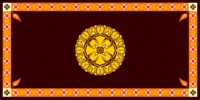
Presidential flag of Sri Lanka – Mahinda Rajapaksa
The flag has a maroon or burgundy field, a yellow ornamental border, the 4 inward-pointing yellow leaves which are also on the main portion of the national flag, and a yellow lotus in the center.
November 14, 1987 –

Flag of Central Province
The flag is designed to represents the Central Province and it’s three districts Kandy, Matale and Nuwaraeliya.
The Golden color Lion that carries a sword and the four Bo leaves at the four corners in the maroon color background represents the Kandy District.
The white lay out represents Matale District and Nuwaraeiya District that represents the Upcountry is symbolized by the white lotus. The Sun and Moon are for Eternity.
January 1, 2007 –

Flag of the Eastern Province
November 14, 1987 –

Flag of the North Central Province
January 1, 2007 –

Flag of the Northern Province
November 14, 1987 –

Flag of the North Western Province
November 14, 1987 –

Flag of the Sabaragamuwa Province
November 14, 1987 –

Flag of the Southern Province
A picture of a lion flag can be seen in frescos in historical Dambulla cave temple. This historical flag made of carving a picture of running lion with a small sword in its forepaw is considered to be the Ruhuna flag.
Furthermore King Dutugamunu left Magam Kingdom with the lion flag ahead for the battle to unite the country. The flag is of a picture of a yellow lion on a red blood colour background. Accordingly it was decided to use for the Southern Provincial flag the picture of the lion running with a small sword (iluk koolaya) in its fore paw of the Ruhuna flag and the red colour and yellow colour of the flag taken in the war front by King Dutugamunu.
It was decided to use the same for the Southern Province flag mixture of colours and the standared to represent all communities in Galle, Matara, and Hambantota and four bo leaves (Metta, Karuna, Muditha, Upeksha) of the national flag.
It was agreed that the forms of the sun and moon of the flag of Southern Province flag should be in the same forms of the sun and moon of the flag of Devinuwara Devalaya and that the same form of that of the flag of Hambantota District. Accordingly it was expected to keep the integration of Galle, matara and Hambantota. Therefore Southern Province flag can be considered as a combination of several traditional flags.
The small sword (iluk Koolaya) is the symbol of control, but it doesn’t reflect terror or suppression. Small sword represents Justice and fair. Running lion represents velocity fearlessness and pride.
The sun and moon stands for stability prosperity and augustness. It expresses the traditional saying “Until the sun and moon exists”. The sun and moon of the flag is considered to be symbols of victory. The combination of colours round the flag depict the existence of Southern Sri Lanka, victorious war history, religion and patriotism, mutual co-operation and harmony.
November 14, 1987 –
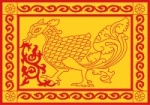
Flag of the Uva Province
In the days of the Sinhala kings, Sri Lanka had been divided into twelve provinces and ruled and each of these twelve provinces had been allotted a flag. Accordingly, in order to bring about qualities such as pleasantness, innocence, greatness and royalty, a flag with a picture of swan had been allotted to the Uva Province.
The flag that was gifted to Uva Province by the King Sri Wickrama Rajasinghe who ruled the kingdom of Kandy during the period 1798-1815 can be seen even today at the National Museum (Courtesy: Book entitled “Uva Ithihasaya” by Panditha Naulle Dhammananda Thero)
November 14, 1987 –

Flag of the Western Province
Reference:
[1] srilankaflags.facts.co – http://srilankaflag.facts.co/srilankaflagof/srilankaflag.php
[2] List of Sri Lankan Flags –
http://en.m.wikipedia.org/wiki/List_of_Sri_Lankan_flags
One thought on “The Sri Lankan National Flag – how it came to be”